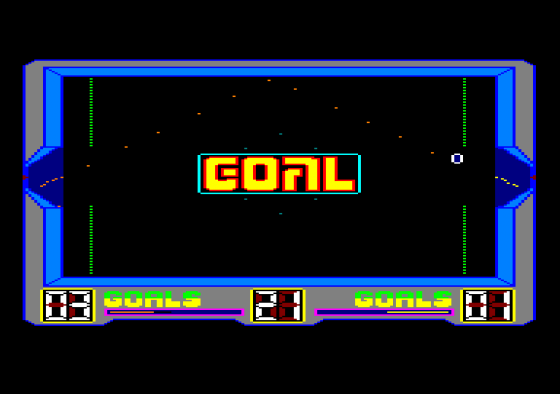
Amstrad Action
 1st March 1986
1st March 1986
Categories: Review: Software
Publisher: Blaby Computer Games
Machine: Amstrad CPC464
Published in Amstrad Action #6
Ricochet
Somebody else obviously played the same games as me as a kid, because this is a version of one of my old favourites, Crossfire, where ball-bearings were fired at a puck on a curving playing area to force it towards the opponent's goal. I thought I'd seen the last of the game years ago but unfortunately I hadn't, even though the ball bearings have been replaced by laser fire.
The playing area is rectangular in shape with a laser gun at either end behind a goal mouth. Two lines angle in from the sides to form a wide funnel towards the goal with the puckstar starting in the middle of the board. By shooting the puckstar with the limited supply of laser bullets, it can be forced in a particular direction. However, the opponent (computer or player) will be trying to move in the other way.
The winner is the first to reach a set target of goals, but a time limit is set on each goal and, if this runs out before one is scored, the puckstar is placed in the centre of the board for the combatants to have another try. That is the bones of the game but the author has tried to embellish it, unsuccessfully, by introducing all manner of weird options and parameters.

The simplest is the size of the goal, but this soon gives way to settings of gravity, collision mode, energy bounce, initial energy and inertia. The exact effect of each of these has to be experimented with to discover but it can do some pretty weird things to the puckstar and the bullets.
You may find the puck becomes immovable and sits in one corner of the table, or that it fails to obey most of the laws of science. The bullets can do the strangest things - curving around in U-turns, stopping dead and rolling backwards, swerving like a baseball pitch in a hurricane or zapping across the board like Concorde with a tail wind.
All this playing around can be interesting for a while but the shallowness of the game and simple display make this a definite non-starter. The best bits of the program are the title music and screens. They flatter to deceive - if the same amount of work had gone into the game, things would have been a lot better.
Second Opinion

I have no happy childhood memories of games like this. This version isn't going to give me any to cherish in my senior citizenship.
Good News
P. Lots of silly parameters to play about with.
P. Nice title music.
Bad News
N. Rotten gameplay, even on the preset parameters.
N. Far too simple and dated game idea.
N. Parameters are too complicated and involved.
N. Title screens and music flatter to deceive.



